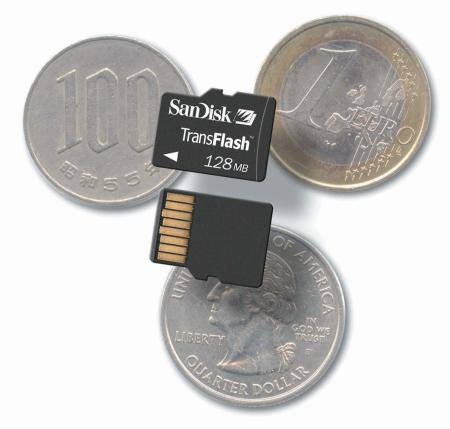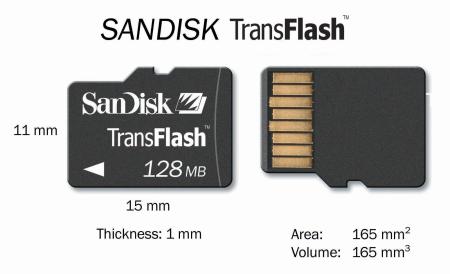New storage technology heralds upgradable smartphones
Aug 2, 2004 — by LinuxDevices Staff — from the LinuxDevices Archive — 3 views SanDisk Corporation has introduced a new line of fingernail-sized removable Flash memory cards that it hopes will become a de facto industry standard for providing user-upgradable internal as well as external storage in the coming wave of smartphones. “TransFlash” cards will debut in smartphones from Motorola.
SanDisk Corporation has introduced a new line of fingernail-sized removable Flash memory cards that it hopes will become a de facto industry standard for providing user-upgradable internal as well as external storage in the coming wave of smartphones. “TransFlash” cards will debut in smartphones from Motorola.

TransFlash cards are meant for internal, as well as external, removable use
Smartphones are mobile phones that provide functionality similar to a computer: customers can access files on the device, edit or delete them, and even install and remove their own software. Thus, smartphones provide a degree of user customization that SanDisk believes should extend to hardware as well as software.
The earliest PCs had memory soldered directly to the motherboard, until standard memory module form-factors and sockets spawned a third-party industry around memory upgrades. Similarly, the removable TransFlash form-factor aims to enable smartphone manufacturers to include the bare minimum of storage capacity, which the customer can then upgrade on an as-needed basis. To support the use of TransFlash as main system storage, SanDisk will offer “under the battery” connectors for the chips, in addition to removable, external slot connectors.
OEM Manager Bo Ericsson said, “Prior to TransFlash, mobile phone manufacturers have been using embedded Flash memory, which is easy to implement but cannot be flexibly upgraded once soldered onto the motherboard. With TransFlash, the handset manufacturer can now design the smallest amount of embedded Flash memory required for the basic operation of the cell phone, and let the customer decide how much additional Flash memory is desired.”
SanDisk also says TransFlash's ability to store operating system code and system data will enable manufacturers and operators to offer customized memory configurations, additional software, and custom carrier bundles that can be easily replaced or upgraded in the field.
Simplyfing the upgrade cycle
TransFlash cards are primarily designed to store personal content such as digital images, MP3 music files, video games, and other applications, phone settings, and personal data. They are likely to remain in the handset for extended periods but can easily be removed and inserted into another phone when consumers want to upgrade their phones.
This usage model is similar to the SIM (Subscriber Identity Module) cards used in most mobile phones worldwide that can be transported by the subscriber from one handset to another. However, SIM cards have very limited Flash memory storage, and suffer from a very slow data transfer rate. TransFlash has approximately half the footprint of SIM cards.
According to SanDisk, “TransFlash has built-in content protection rights management to allow secure downloads of content such as songs, video clips and video games. Future versions of TransFlash are being developed which will offer advanced encryption security to permit protected storage of personal, financial, and medical information.”
CEO Eli Harari said, “Third generation (3G) cell phones starting this year will have a profound effect on consumer electronics, similar to what we saw a decade back with the advent of the web. The vastly improved wireless transmission rates of data and multimedia content of 3G networks will completely transform the usage pattern of handsets. Cell phones will become the dominant form of portable music playing, and will offer the capabilities not only of digital cameras but also of good quality video camcorders. All this will require substantially more Flash storage. TransFlash offers all the low cost and small size benefits of embedded Flash, with all the flexibility benefits of removable cards.”
“We plan to accelerate our TransFlash design-in activities with leading handset manufacturers globally, to make TransFlash a de facto standard,” Harari added.
Randy Giusto, vice president of technology and services at IDC, commented, “As cell phones add new features, storage becomes increasingly important. The worldwide market for cell phones is growing from 536 million in 2003 to 745 million in 2007 and the anticipated capacity needs for embedded memory will grow as well. Mobile phone users will continue to demand more applications as next generation phones begin to offer enhanced audio and video capabilities which will increasingly drive storage requirements higher.”
About TransFlash
The TransFlash cards were known as “T-Flash” during development. They measure 0.43 x 0.39 x 0.04 inches (11 x 15 x 1 mm), or about the size of a fingernail, or a quarter of the volume of the smallest removable Flash chips previously available, according to SanDisk.

TransFlash dimensions
(Click to enlarge)
TransFlash cards are based on NAND MLC Flash memory and controller technologies, which are also used in SanDisk's miniSD (photo) and TriFlash products. According to SanDisk, TransFlash chips will allow handset manufacturers to incorporate significant amounts of removable storage capacity into progressively smaller handsets.
TransFlash chips will appear initially in several 3G phones from Motorola, including the Linux-based A780 announced last week, as well as the E1000 and A1000. Motorola Product Manager Chris Swambar said, “TransFlash memory offers us the flexibility to pursue smaller, sleeker designs.”
Availability
TransFlash cards are sampling to device makers, with volume production expected in the second quarter of 2005. Pricing ranges from $14 to $39 for capacities from 32MB to 128MB. An SD card adapter will enable TransFlash cards to work in standard SD slots, allowing mobile users to exchange data with SD-slot equipped digital cameras, laptops, or PDAs. Adapters and cards will hit retail outlets “later in the year,” according to SanDisk.
This article was originally published on LinuxDevices.com and has been donated to the open source community by QuinStreet Inc. Please visit LinuxToday.com for up-to-date news and articles about Linux and open source.